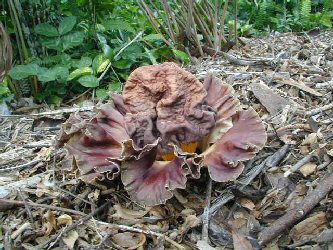We shall return ...
(and so we did.)
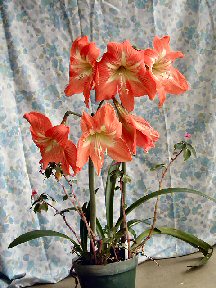
The hurricane damage that rarely gets articles written about it is the effect on a shade garden of the full roasting by the sun. I was able to give some temporary shade to the most sensitive plants (plenty of palm fronds lying around), and, fortunately, once the power was restored the sprinkler system only needed minor first aid to fix the gushers and stand up some pipes. (Fortunate indeed since the hurricane was followed by a scorching three-week drought.) Also, since Hurricane Wilma devastated us in late October, many of the gingers were starting to think about their winter dormancy, and went underground (if a little precipitously).
But what would the following spring and summer bring? The trees, including the palms, had almost all been sheared at a height of about six to ten feet. Those not hit as badly were tipped or had branches snapped and were leafless. I have to repeat with some pride that years of pruning and shaping had given most trees a strong branching pattern and there were no split trunks from multiple leaders with which to deal.
 |
Some needed and still need a little help in standing up. And not all of the trees that were standing would live, but would announce this by slipping slowly away as the summer went on. (Sorry to see you go, Governor's plum and carambola, peltophorum and solitaire palms: hang in there lychee and jaboticaba!) |
I have to say that my worst fears were groundless. The early push into dormancy didn't seem to hurt the kaempferias, which came up on schedule and produced enormous leaves, if anything larger and more colourful than usual. Strangely enough, they did this in spite of curling up on themselves and writhing in apparent pain each day as the sun got brighter, and they have stayed above ground deep into the winter.
| Elephant ears, of course were smashed in the storm, but with plenty of water started to unfurl new leaves and quite quickly recovered ther majestic six- to eight foot height and spread. |
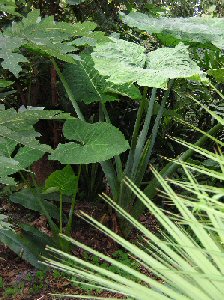 |
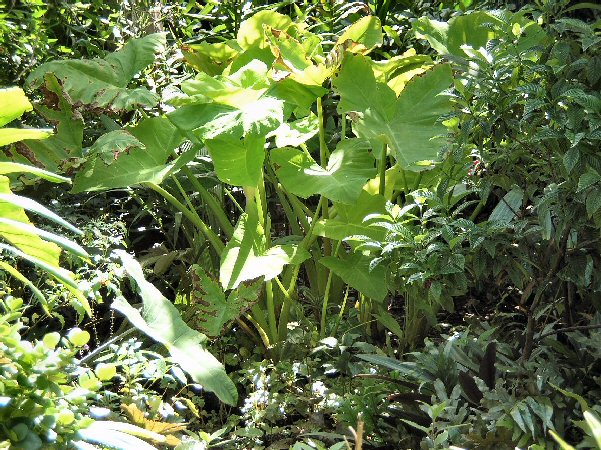 |
Even the charteuse-leaved form which has a more delicate appearance, has prospered, and the single head is now eight forming a happy clump, and has been the source of several pass-along plants through the year. |
|
Other aroids flourished with extra light, and my Amorphophallus paeonifolius outdid themselves with their nightmare blooms followed by six-foot high single leaves.
|
 |
One piece of trail reconstruction has turned out to be rather fun. When the big avocado went down we cut the trunk off at about eight feet above the roots to see where things would go. What went was a rash of new shoots that were thinned to five spaced along the trunk, which have grown to almost twelve feet tall (each). I have topped these, deciding to try for a lower tree, as long as it lives. It has flowered now, a year and a half after the destruction, setting a small crop. The trail remaking comes in because two of the major roots are sticking across what was the path, about two feet above ground level. Cut them (major roots) and risk killing the phoenix-like regrowth? No, we built a bridge.
Every man should build at least one bridge in his lifetime, and while this one doesn't mean lifesaving ease of communication to an off-shore island, it does re-establish circulation in the garden.
|
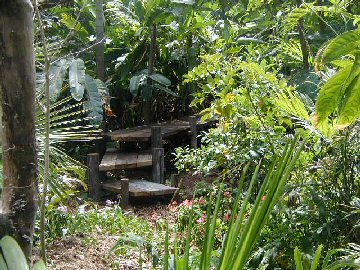 |
 |
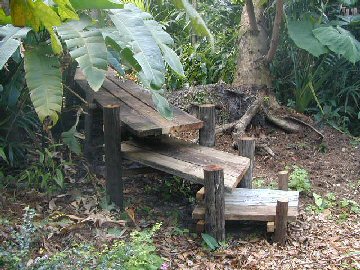 |
The plants which I already knew to be sunlovers have really gone to town. Flowering shrubs have flowered profusely, fragrant plants have filled the evening garden with scent, and the heliconias have been eye-stopping.

![]()
The smaller logs from the downed trees have been used as a casual edging for the paths. As the year has worn on the logs have been invaded by breakdown fungi, giving a serendipitous show of unusual colour.
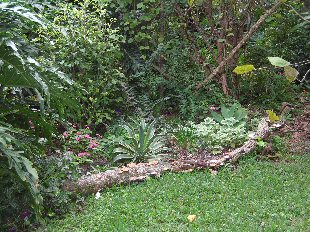

And one more joy, in passing. The longwing butterflies, which have an interesting part of their behavior pattern that brings them together each night, have moved from the back area of the garden to cluster now on a ponytail right outside the french doors. If we time breakfast right, we can watch them warm as the first sun's rays reach them, and take off one by one to explore for nectar and pollen, and give movement again to the garden. |
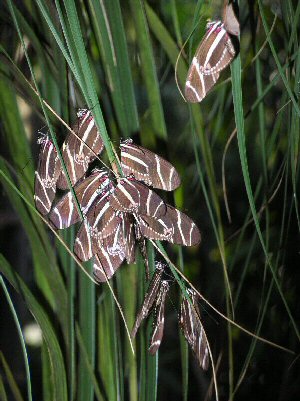 |
I have been reminded of a relationship which I think I have known before,
that is that additional water can ease the stress on a plant from stronger
light levels. I have been fortunate in being able to give ample water
from my well through the summer.
The opposite side of the relationship is also true to a degree, in that, in shade, many plants can do well with less water. This is going to become of more and more significance as water supplies come under more stress in South Florida from the rapid development which the municipalities seem unable or unwilling to control. Money talks, and there are many greedy hands reaching out.
For us the South Florida problems of the future may become moot. I have just got my new house insurance bill which has gone up 400% from last year's and that is without having filed a claim for 27 years. Doesn't seem right somehow.
On to a little more garden
Back to the start of the garden ramble
Back to the home page
